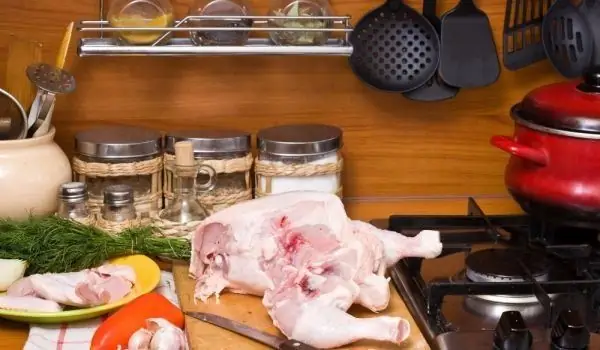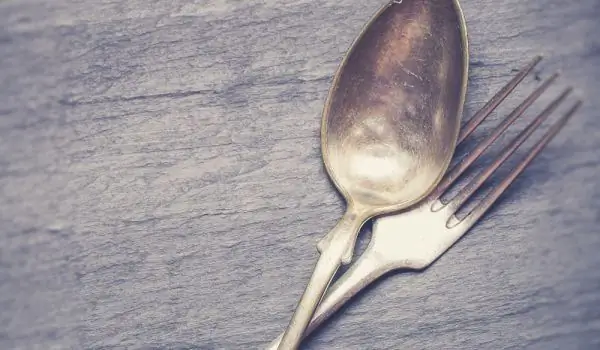2025 Author: Jasmine Walkman | [email protected]. Last modified: 2025-01-23 10:18
According to researchers in experimental psychology from Oxford, the taste of food in the mouth depends not only on it, but also on the utensils we use. The weight, shape, color and size of the utensils matter whether this food will seem saltier or sweeter.
The researchers' study was published in the journal Flaver. The results are clear that the human brain makes judgments about what it puts in its mouth before food is eaten.
The study involved more than 100 students who underwent three experiments - the aim was to demonstrate that the color, shape and even the weight of the instruments are important for the taste we feel. Silver-plated metal spoons were used, as well as plastic spoons, which had a variety of colors. Additional weights are added to some of the devices.
It turns out that when the weight is contrary to people's expectations, food is taken in one way, and in another, when it is consistent. The traditional small spoons, with which it is customary to eat dessert, turn out to be more preferred - the food is sweeter when consumed with them, experts say.

However, when the same teaspoons turned out to be heavier than expected, three times, the yoghurt was assessed as less thick. The colors in the utensils and their contrast with the food also matter.
Milk, which, as you know, is white, looks most appetizing in a white spoon. Served with a black spoon, it is definitely perceived as less sweet, scientists say. If you serve it with a blue spoon, it is possible that it will taste even slightly salty.
Pink fruit milk served with a blue spoon is also less sweet than if eaten with a pink spoon. When the participants in the experiment were given a plastic and a metal spoon, it turned out that the milk in the plastic seemed fatter.
When participants were asked to take a piece of cheese for the next experiment with a toothpick, fork, knife or spoon, the students indicated that the cheese from the knife was the saltiest.

Professor Charles Spence and Dr. Vanessa Harr are convinced that when it comes to how delicious a food is, several senses are involved. It is not enough for the food to be fragrant, to look good, it is also important what it feels like.
And before we put it to our mouths, our brains have already judged it - this largely determines how we will perceive it. No less important is the atmosphere.
Previous research has shown that other factors, such as the size and color of cups and plates, are also important. In smaller plates a person eats less, in large plates the portion seems too small, and we feel as if we have eaten half.
If you want to reduce your appetite, you can eat from blue plates, according to another study. You can also add a larger fork to the blue plate, which also stops the appetite. For the opposite effect, serve your food in yellow or orange plates.
Recommended:
Denmark Is Introducing A Radical Change In Baby Food Packaging

To solve the problem of misleading baby food packaging, Denmark is introducing a radical change in the sale and advertising of products intended for children. They became the first European country to ban the use of familiar cartoon characters on packaging and in advertisements for harmful baby foods.
What Utensils And Utensils Should Be In Every Kitchen

A well-arranged kitchen, equipped with the necessary equipment, is very important for the successful work of the hostess. The more kitchen utensils and cutlery the housewife has, the more pleasant and easy her work is. Kitchen utensils must be made of a material that does not alter the appearance, taste, aroma of food and does not form chemical compounds with food that could cause poisoning.
Food Has A Different Taste 3 Kilometers From Earth

Little is known that the taste of food is not the same at different altitudes. This statement is discussed in detail in the well-known among culinary experts - aircraft theory. She cites as evidence the fact that the food consumed in flying planes tastes different from what is eaten on the ground.
Silver Utensils Ruin The Taste Of Food

In the hidden drawers of deep cabinets almost all of us keep a set of silverware for special occasions or for beloved and valuable guests. But are you sure that beautifully decorated forks and knives made of silver will be the best choice for an unforgettable and delicious dinner?
Protect Your Palate: Harmful Ingredients In Foods That Change Our Taste

When your daily diet includes chemically flavored foods, it is very likely that over time your body will lose the ability to recognize the right way to smell real foods and not be able to enjoy their taste. The artificial enhancers deceive our mind and it gets used to them and decides that they are more nutritious and useful than, say, fruits and vegetables.

